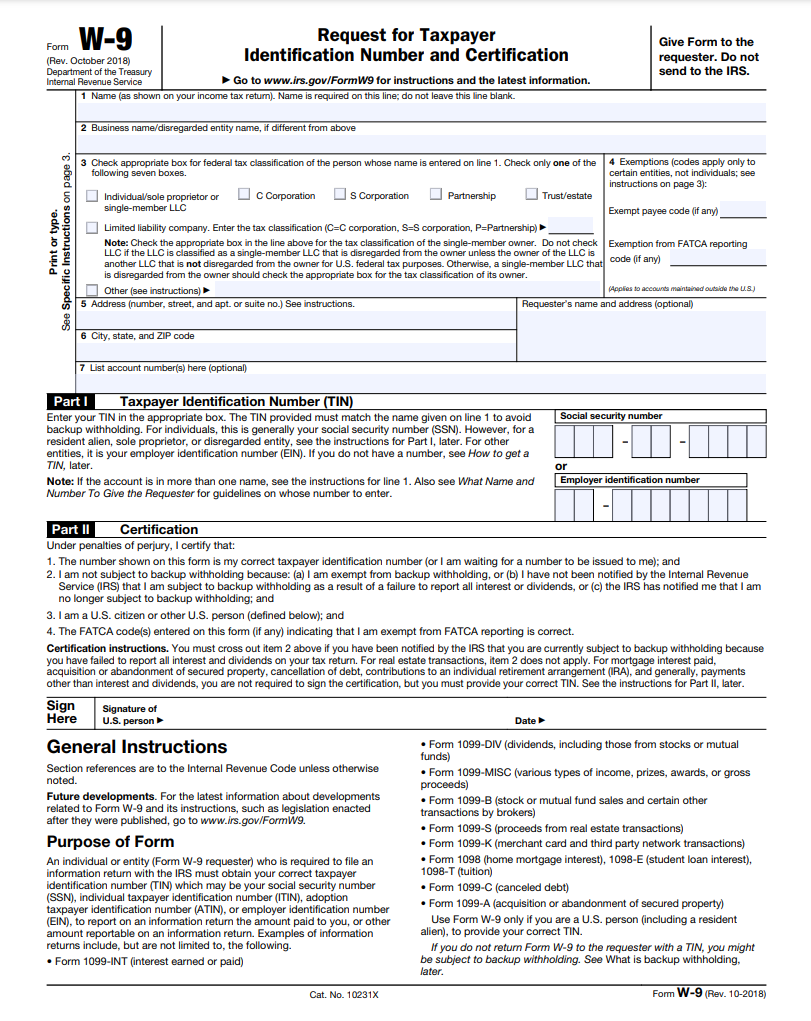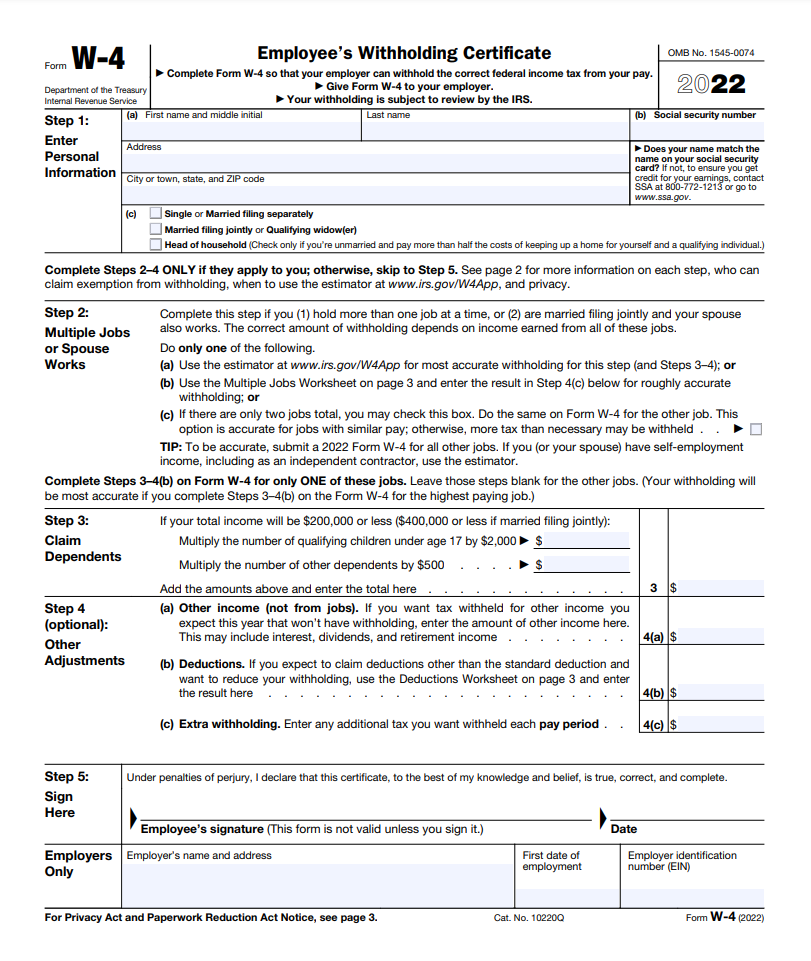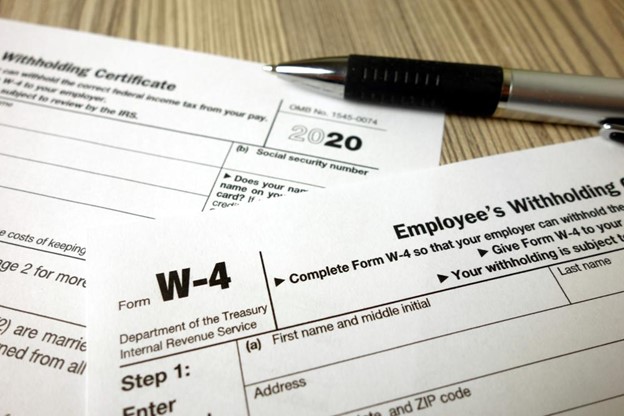W-9 vs W-4 Forms: What’s the Difference?

There are over 800 different Internal Revenue Service (IRS) tax documents in the United States.
At the end of the tax year, it’s essential that you understand which forms apply to you and how to fill them out correctly. Two of the most common tax documents are Forms W-9 and W-4. Due to their similarities, these are also the forms that people get confused by the most.
In this article, we outline what the differences are between Forms W-9 and W-4, as well as how to fill them out and create them online easily.
A Quick Recap on the Internal Revenue Service (IRS)
The Internal Revenue Service (IRS) is a US government agency responsible for the collection of federal taxes and enforcement of tax laws. It was established in 1862 by President Abraham Lincoln and operates under the authority of the U.S. Department of Treasury. The primary purpose of the IRS is to collect individual income and employment taxes, as well as corporate, gift, excise and estate taxes.
What is a Form W-9?

The Form W-9 is also known as the “Request for Taxpayer Identification Number (TIN) and Certification.”
This is a one-page tax form that employers use to get the TIN from self-employed workers and independent contractors.
Who qualifies as an independent contractor?
An independent contractor is defined by several key characteristics that distinguish them from traditional employees. Independent contractors typically:
- Have full control over when and how they complete their work.
- Do not receive employee benefits such as health insurance, 401(k) matching, or paid leave.
- Are responsible for paying all their own taxes (including self-employment tax).
Other commonly used terms for independent contractors include vendors and freelancers.
Independent contractors work across various industries. Common examples include:
- Consultants
- Graphic designers
- Writers
- Landscapers
- Repair professionals
Understanding Non-Employee Compensation
One of the defining features of an independent contractor is that they receive non-employee compensation from the businesses they work with. This compensation can take several forms, including:
- Fees
- Commissions
- Prizes and awards for services rendered
The Role of Form W-9 for Independent Contractors
To facilitate tax reporting, independent contractors must provide their clients with a Form W-9, which includes their:
- Full legal name
- Address
- Taxpayer Identification Number (TIN)
Unlike other tax forms, Form W-9 is not filed with the IRS. Instead, it is submitted to the company’s payroll department or the contractor’s supervisor.
Form 1099-MISC and Tax Filing Requirements
At the end of the tax year, independent contractors who earned $600 or more from a client must:
- Submit a Form W-9 to their client to receive a Form 1099-MISC in return.
- File the 1099-MISC with the IRS to report their income.
Important Filing Deadlines
Independent contractors must submit their Form W-9 to clients before January 31st each year.
*If January 31st falls on a weekend or holiday, the deadline moves to the next business day.*
Form W-9 and Tax Implications:
The Form W-9 also acts as an agreement that independent contractors are responsible for withholding taxes from their own income. Full-time employees have their federal income taxes, Medicare and Social Security taxes withheld from their paychecks by their employers.
Since independent contractors are self-employed, they are responsible for handling their own tax withholdings, as they do not have an employer to do it for them.
What Do Independent Contractors Include on a Form W-9?
- The name of the payee or their business name.
- The payee’s federal tax classification. This could be a single-member limited liability company (LLC), C Corporation, S Corporation or an individual/sole proprietorship.
- The payee’s current, full mailing address.
- The payee’s taxpayer identification number (TIN), which includes either an Employer Identification Number (EIN) or Social Security number.
What is a Form W-4?

Form W-4, also known as the “Employee’s Withholding Allowance Certificate,” is a federal form that employees must complete when starting a new job.
Employers use the Form W-4 to determine how much income tax to withhold from their employees’ paychecks. The amount of income tax withheld from the employee will be based on their wages and the number of withholding allowances they qualify for. Withholding allowances are based on the employee’s filing status, how many dependents they have, and their anticipated tax credits and deductions.
It’s important that employers make sure that the information on each of their employee’s’ Form W-4s is correct. If the incorrect amount is withheld from an employee’s paycheck, they could face expensive tax bills or penalties from the IRS.
Employees must ensure that their Form W-4s are submitted to employers within the first month of starting a new job.
What Do Employees Include on a Form W-4?
- Full name, postal address and ZIP code.
- Social Security number.
- Marital status.
- How many dependents they have.
- Any additional money the employer should withhold. This could include Medicare taxes or passive income from investments.
Comparing Forms W-9 and W-4
Now that you have a better idea of what Forms W-9 and W-4 are, let’s take a closer look at their differences and what their implications are for taxpayers.
Form W-9 vs W-4: Key Differences at a Glance
| Form W-9 | Form W-4 |
| Independent contractors fill out a Form W-9. | Employees fill out Form W-4. |
| Self-employed workers use the Form W-9 to provide their taxpayer identification number (TIN) to companies that they do work for. | Employees use the Form W-4 to inform their employers of how much income tax to withhold from their paycheck. |
| W-9 Forms should be submitted to employers before the 1099 deadline, which is usually January 31st. | W-4 Forms should be submitted to employers within the first month of starting a new job. |
| Businesses send a blank Form W-9 to complete before independent contractors start working for them. | Ideally, employers should issue their employees with a Form W-4 on their first day. |
| Independent contractors can file a Form W-9 annually, but it is not required. | Employees need to file a new Form W-4 each time they start a new job or need to report changes to their financial situation. |
Understanding the Difference Between Form W-4 and Form W-9
The key distinction between these two forms is who fills them out:
- Form W-4 is completed by employees to determine how much tax their employer should withhold from their paycheck.
- Form W-9 is filled out by self-employed individuals (independent contractors) to provide their tax information to businesses they work with.
The Purpose of Form W-9:
Unlike Form W-4, which directly affects payroll tax withholdings, Form W-9 is simply an information return. It allows businesses to collect an independent contractor’s personal details and Taxpayer Identification Number (TIN) but is not submitted to the IRS.
Independent contractors provide a Form W-9 to every company they work with so they can receive a Form 1099-MISC at the end of the tax year, which reports their earnings. Since independent contractors do not have employer handling tax withholdings, they are solely responsible for ensuring they pay the correct amount of income tax to the IRS.
If an independent contractor works with multiple companies, they may need to complete several Form W-9s within the same year.
The Role of Form W-4 for Employees:
In contrast, Form W-4 is used exclusively by employees and has direct implications for employers. This form tells employers how much tax to withhold from each paycheck based on the employee’s financial situation.
Employees must submit a new Form W-4 whenever their financial circumstances change, such as:
- Starting a new job
- Changing marital status
- Having a child
- Receiving a pay raise
These updates are important for employers, as they may affect payroll tax calculations throughout the year.
Do You Have to Fill Out Forms W-9 and W-4?


Self-employed workers don’t always need to fill out a Form W-9. However, many businesses ask independent contractors to complete one to avoid costly penalties from the IRS. If an independent contractor refuses to complete a Form W-9, the company that they work for can withhold a certain percentage from their pay.
This process is known as backup withholding and could mean that the employer withholds 28% of your pay and submits it to the IRS. If you choose not to complete a Form W-4, the employer will still provide you with a paycheck.
However, employers will have to withhold income taxes at the highest rate for single filers with no other adjustments. This could mean that you pay more tax than what is necessary.
Say Goodbye to W-9 and W-4 Form Guesswork
We know that the process of creating and filling out IRS forms can be overwhelming and time consuming. That’s why our Form W-9 and Form W-4 generator has been designed to be efficient and easy to use.
Employers and independent contractors can easily produce, fill out and print Forms W-9 and W-4 in a matter of minutes.
We also don’t require our customers to download any additional software, which will save you even more time and money. With our affordable subscription plan, you can create unlimited Form W-9s and W-4s at a low cost.
FormPros Has You Covered
Simplify your paperwork with FormPros! From creating paystubs, W-2s, and 1099-NEC forms to generating LLC Operating Agreements and even voided checks, our easy-to-use platform has you covered. Save time, reduce errors, and handle your business documents with confidence. Start now and see how FormPros makes professional form generation fast, affordable, and hassle-free!
We can help you!
- Instant download
- Preview pre-purchase
- Expert help
- Step by step instructions
- 100% Money-back Guarantee